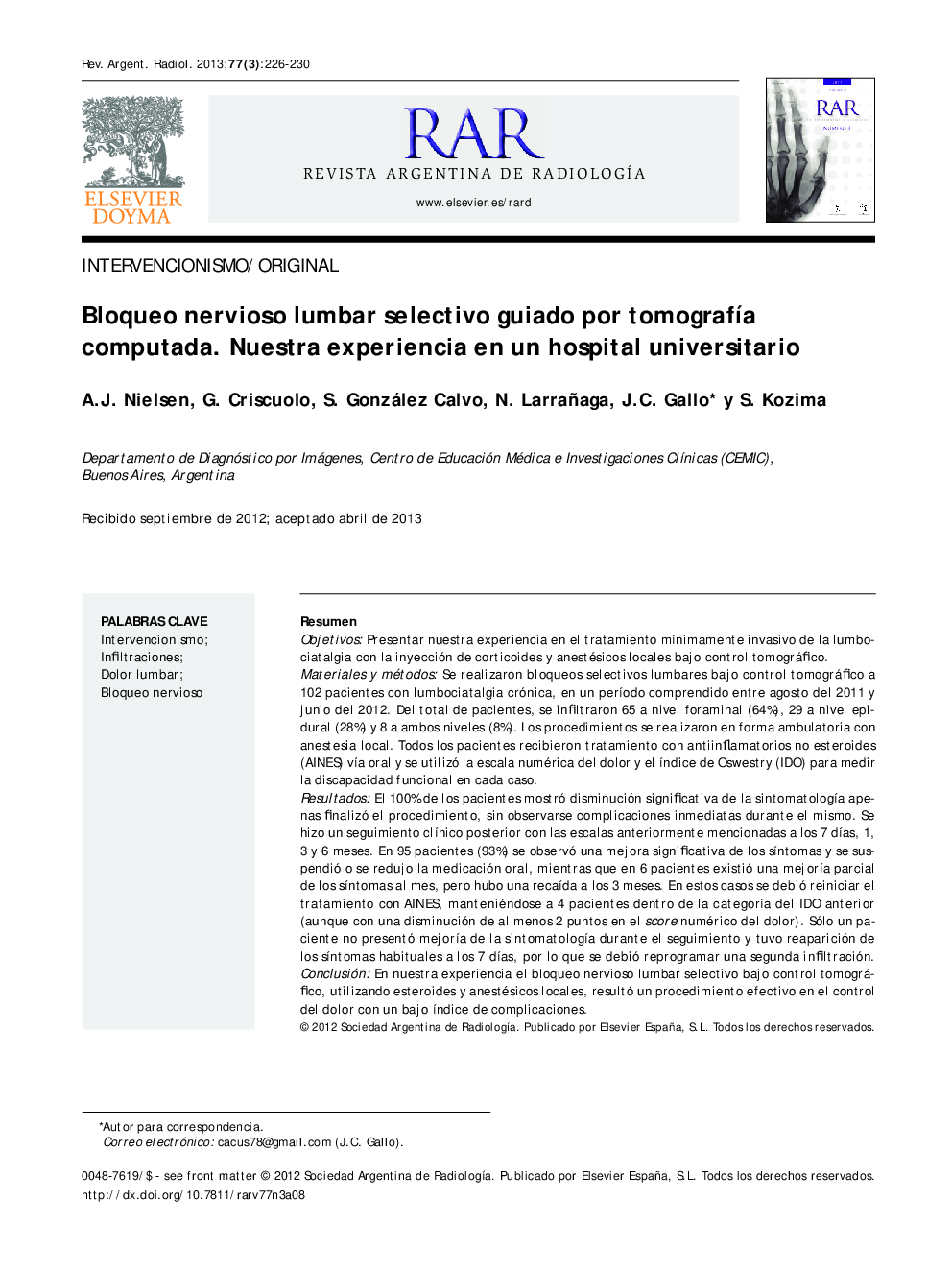| Article ID | Journal | Published Year | Pages | File Type |
|---|---|---|---|---|
| 4248773 | Revista Argentina de Radiología | 2013 | 5 Pages |
ResumenObjetivosPresentar nuestra experiencia en el tratamiento mínimamente invasivo de la lumbociatalgia con la inyección de corticoides y anestésicos locales bajo control tomográfico.Materiales y métodosSe realizaron bloqueos selectivos lumbares bajo control tomográfico a 102 pacientes con lumbociatalgia crónica, en un período comprendido entre agosto del 2011 y junio del 2012. Del total de pacientes, se infiltraron 65 a nivel foraminal (64%), 29 a nivel epidural (28%) y 8 a ambos niveles (8%). Los procedimientos se realizaron en forma ambulatoria con anestesia local. Todos los pacientes recibieron tratamiento con antiinflamatorios no esteroides (AINES) vía oral y se utilizó la escala numérica del dolor y el índice de Oswestry (IDO) para medir la discapacidad funcional en cada caso.ResultadosEl 100% de los pacientes mostró disminución significativa de la sintomatología apenas finalizó el procedimiento, sin observarse complicaciones inmediatas durante el mismo. Se hizo un seguimiento clínico posterior con las escalas anteriormente mencionadas a los 7 días, 1, 3 y 6 meses. En 95 pacientes (93%) se observó una mejora significativa de los síntomas y se suspendió o se redujo la medicación oral, mientras que en 6 pacientes existió una mejoría parcial de los síntomas al mes, pero hubo una recaída a los 3 meses. En estos casos se debió reiniciar el tratamiento con AINES, manteniéndose a 4 pacientes dentro de la categoría del IDO anterior (aunque con una disminución de al menos 2 puntos en el score numérico del dolor). Sólo un paciente no presentó mejoría de la sintomatología durante el seguimiento y tuvo reaparición de los síntomas habituales a los 7 días, por lo que se debió reprogramar una segunda infiltración.ConclusiónEn nuestra experiencia el bloqueo nervioso lumbar selectivo bajo control tomográfico, utilizando esteroides y anestésicos locales, resultó un procedimiento efectivo en el control del dolor con un bajo índice de complicaciones.
ObjectivesTo present our experience with minimally invasive treatment of low back pain and sciatica with the computed tomography-guided percutaneous injection of steroids and local anaesthetics.Materials and methodsFrom August 2011 to June 2012, 102 patients underwent selective computed tomography-guided foraminal block for low back pain and sciatica treatment. Sixty-five patients received foraminal infiltration (64%), 29 epidural infiltration (28%), and 8 (8%) were subject to combined procedures. All procedures were performed on an outpatient basis with local anaesthetic, with no immediate complications. All patients received oral NSAIDs (non-steroidal anti-inflammatory drugs) prior to the procedure. A numeric scale of pain and the Oswestry index (IDO) was employed to measure local pain and limb disability. All patients showed at least 7 points in the initial evaluation.ResultsAll the patients showed a significant reduction in pain by the end of procedure. A clinical follow-up was made after 7 days, 1, 3, and 6 months after the treatment using the previously mentioned scales. Ninety-five patients (93%) showed a significant improvement in their symptoms, with suspension or decrease in oral medication. Six patients showed only a partial reduction of symptoms during the follow-up after one month, with a recurrence of symptoms after 3 months and restarted oral treatment. Four of these patients remained in the same IDO category with at least a 2 point decrease in the pain scale. Only one patient showed no improvement in symptoms during follow-up with a recurrence of symptoms 7 days after procedure, and for whom a second procedure was reprogrammed.ConclusionIn our experience CT-guided percutaneous lumbar selective nerve block using steroids and local anaesthetics, is an effective method of pain control with a very low incidence of complications.
